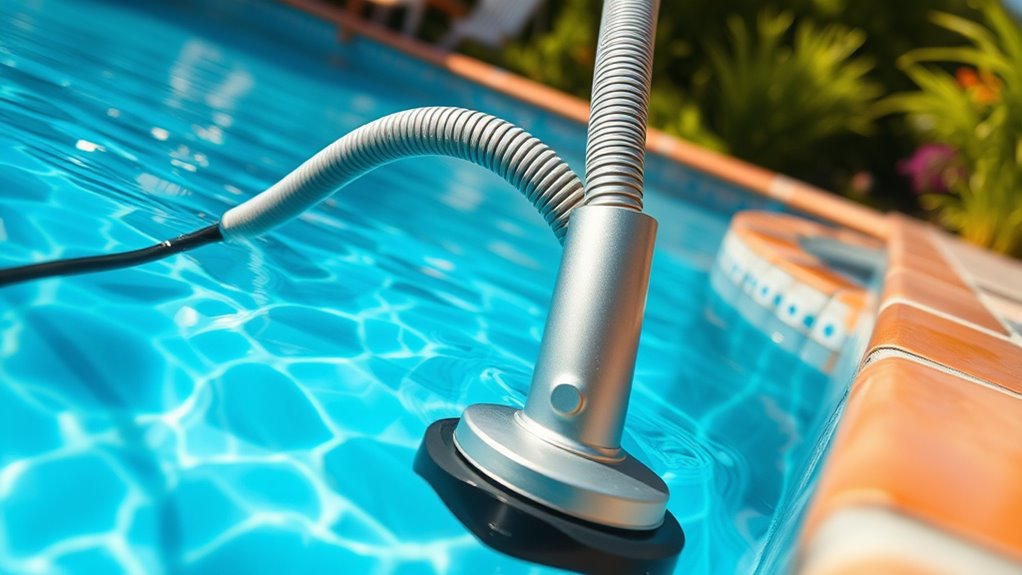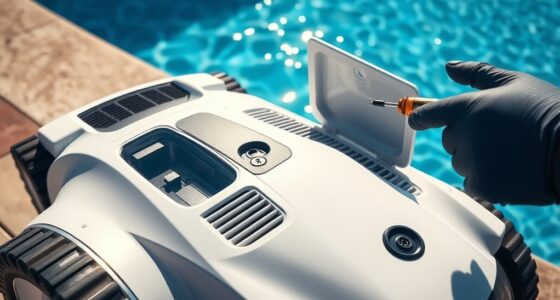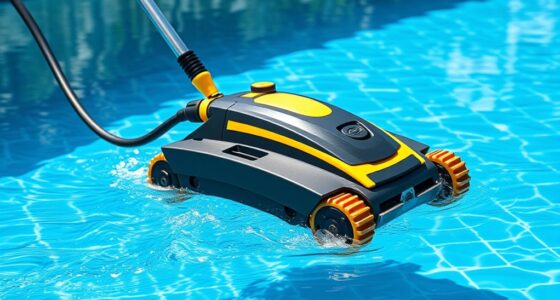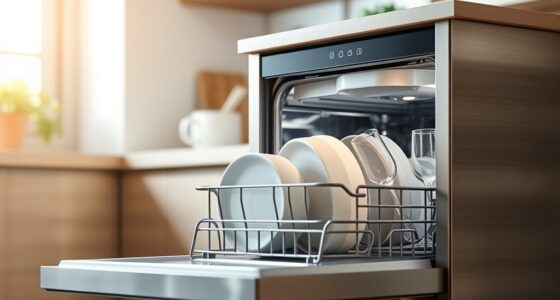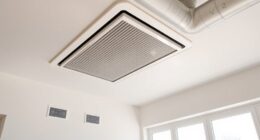If your pressure pool cleaner isn’t working well, start by inspecting hoses, fittings, and wheels for cracks, obstructions, or leaks, and secure all connections. Check the pool’s pump pressure and confirm filters and skimmer baskets are clean. Make sure system valves are fully open and hoses aren’t clogged. Regular maintenance of internal parts and monitoring pressure levels help prevent future issues. Keep an eye on potential causes to keep your cleaner running smoothly. More tips await to help you troubleshoot effectively.
Key Takeaways
- Check hoses, swivels, and wheels for damage or obstructions, and ensure all fittings are secure.
- Verify that the pool pump is operating correctly and providing adequate pressure.
- Clean or replace clogged filters, skimmer baskets, and unclog hoses to restore water flow.
- Inspect internal parts like turbines and gears for wear or damage and replace if needed.
- Regularly monitor pressure levels and address leaks or blockages promptly to prevent system issues.

A pressure pool cleaner is an efficient way to keep your pool sparkling, but when it stops working properly, it can be frustrating. You might notice it losing power, not moving correctly, or failing to pick up debris. The first step in troubleshooting is to understand how your cleaner operates, especially its pool cleaner parts and the pressure system that powers it. These components work together to create the suction and movement needed to clean your pool effectively.
Start by inspecting the pool cleaner parts, such as the hoses, swivels, or wheels, for any visible damage or obstructions. Sometimes, debris or tangled hoses can restrict water flow, reducing the pressure needed for proper operation. Check that all connections are secure; loose fittings can cause leaks that diminish pressure and performance. If the hoses are cracked or brittle, replacing them ensures the pressure system works at ideal levels. Also, examine the cleaner’s wheels or brushes for debris buildup or wear; these parts are essential for movement and cleaning efficiency. Proper maintenance of these parts can significantly extend the lifespan of your pool cleaner.
Inspect hoses, swivels, and wheels for damage or obstructions to ensure optimal water flow and performance.
Next, focus on the pressure system itself. The cleaner relies on water pressure to operate; if the pressure isn’t adequate, the cleaner won’t move properly. Verify that your pool’s pump is working correctly and providing the necessary pressure. Low pump pressure can stem from clogged skimmer baskets, dirty filters, or closed valves. Clean or replace filters regularly, and ensure all valves are fully open to maximize water flow. You can also test the pressure by attaching a pressure gauge to the return line; if the gauge reads below the manufacturer’s recommended PSI, you may need to boost your system’s pressure or address underlying issues. Regularly monitoring system pressure helps prevent unexpected breakdowns and maintains optimal cleaning performance.
Another common problem is an improper setup or blockages in the system. Check the pool’s skimmer and return jets for obstructions, as these can affect the overall pressure in your system. When the pressure is too high or too low, it indicates a problem in the circulation. If the pressure system isn’t providing consistent water flow, your pressure pool cleaner won’t perform correctly. Adjust the settings or repair any leaks in the hoses or fittings. Sometimes, simply cleaning the debris from the pool’s filter or unclogging the hoses restores the necessary pressure. Ensuring proper system setup and maintaining clear pathways for water flow are crucial steps in troubleshooting performance issues. Additionally, understanding how pressure systems operate helps in diagnosing and preventing future problems.
In some cases, the problem may be with the cleaner’s internal components, such as the turbine or internal gears. If you’ve checked everything externally and the pressure system seems fine, consider opening the cleaner to inspect these parts. Worn or damaged internal parts can cause a drop in performance, requiring replacement. Regular maintenance and inspection of pool cleaner parts and the pressure system help prevent future breakdowns and keep your pool clean with minimal hassle. Proper knowledge of the pressure system components can also assist in more precise troubleshooting and repairs.
Frequently Asked Questions
How Often Should I Perform Maintenance on My Pressure Pool Cleaner?
You should follow a regular maintenance schedule to keep your pressure pool cleaner working efficiently. Typically, you should perform cleaning frequency checks weekly, inspecting and cleaning brushes, filters, and hoses. Regular maintenance guarantees peak performance and prevents issues. Don’t forget to remove debris and check for wear and tear. Staying consistent with your maintenance schedule helps prolong your cleaner’s lifespan and keeps your pool sparkling clean.
Can I Use the Cleaner During the Pool’s Filtration Cycle?
You can use your pressure pool cleaner during the pool’s filtration cycle, but for pool safety and ideal cleaning, it’s best to follow your cleaning schedule. Running the cleaner during filtration helps keep the water clear and debris-free, but avoid overusing it, as this can strain your system. Always monitor your cleaner’s performance and guarantee your filtration system is working efficiently to maintain a clean and safe swimming environment.
What Safety Precautions Should I Take During Troubleshooting?
Imagine sparks flying as you work, danger lurking just beneath the surface. Before troubleshooting, you should prioritize electrical safety—always disconnect the power supply and avoid working near water. Wear personal protective equipment like gloves and goggles to shield yourself from potential hazards. These precautions protect you from shocks and injuries, ensuring a safer experience. Stay alert, follow safety protocols, and keep hazards at bay while you resolve the issue.
Are There Compatible Replacement Parts for My Pressure Cleaner Model?
You might wonder if there are compatible replacement parts for your pressure cleaner model. To avoid compatibility issues, check the manufacturer’s specifications or consult your user manual. Many brands offer parts designed specifically for their models, ensuring proper fit and function. You can also contact customer support or visit authorized dealers to find the right replacement parts. Always verify compatibility before purchasing to keep your cleaner running smoothly.
How Do I Prevent Future Clogs and Blockages?
You might think preventing clogs is complicated, but it’s simple with regular filter maintenance. To prevent future blockages, clean your filter frequently to catch debris early, ensuring smooth operation. Keep the skimmer and pump baskets clear, and remove leaves or debris from the pool surface. By staying proactive with debris prevention, you’ll reduce pressure cleaner clogs and keep your pool spotless all season long.
Conclusion
Now that you’ve learned how to troubleshoot your pressure pool cleaner, you’ll be better equipped to keep your pool sparkling clean. Did you know that regular maintenance can extend your cleaner’s lifespan by up to 30%? Staying proactive not only saves you money but also guarantees your pool stays pristine all season long. Keep an eye on common issues, and you’ll enjoy hassle-free swimming whenever you want. Happy cleaning!
